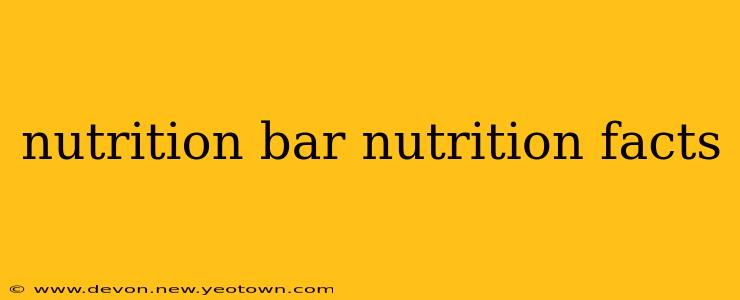Let's be honest, nutrition bars have become a staple in many of our lives. Whether it's a quick breakfast on the go, a post-workout fuel-up, or a satisfying afternoon snack, these convenient bars promise a nutritional boost. But deciphering the often-confusing nutrition facts label can be a real challenge. This isn't just about calories; it's about understanding what you're actually putting into your body. This guide will walk you through the key components of a nutrition bar label, empowering you to make informed choices.
Imagine this: Sarah, a busy professional, grabs a nutrition bar every morning. She believes she’s making a healthy choice, but she's often confused by the long list of ingredients and the seemingly conflicting nutritional claims. This story is relatable to many of us, which is why understanding the nutrition facts label is crucial.
What are the Key Components of a Nutrition Facts Label?
Let’s break down the crucial information found on a nutrition bar’s label. We'll explore the elements that truly matter and help you understand what to look for when making healthy choices.
Serving Size: The Foundation of Understanding
The serving size is the cornerstone of interpreting the entire nutrition facts label. Pay close attention to this, as the values listed for calories, fat, sugar, and other nutrients are all based on this single serving. Many bars might be two or more servings, so if you eat the whole bar, you need to multiply the listed values accordingly.
Calories: The Energy Equation
Calories represent the energy your body gets from the bar. While calories themselves aren’t inherently good or bad, keeping track of your daily caloric intake is essential for weight management. Pay attention to the calorie count relative to your overall dietary needs.
Macronutrients: The Big Three – Fat, Carbohydrates, and Protein
-
Fat: Not all fats are created equal. Look for the breakdown of saturated, trans, and unsaturated fats. Saturated and trans fats should be limited in your diet. Unsaturated fats, on the other hand, are beneficial for heart health.
-
Carbohydrates: Carbs provide energy. The label will usually show total carbohydrates, as well as the amounts of dietary fiber and added sugars. Fiber is crucial for digestion and overall health, while added sugars should be consumed in moderation.
-
Protein: Protein is essential for building and repairing tissues. Higher protein bars are often favored by those focused on muscle growth or recovery after exercise.
Micronutrients: The Essential Vitamins and Minerals
The label will often list vitamins and minerals, such as iron, calcium, and vitamin D. While these are important, don't solely rely on nutrition bars to meet your micronutrient needs. A balanced diet is key.
How Much Sugar is Too Much in a Nutrition Bar?
Many nutrition bars contain a surprising amount of added sugar. How much is too much? The American Heart Association recommends a maximum of 25 grams of added sugar per day for women and 36 grams for men. Check the label carefully and compare the added sugar content to your daily limit.
What are the Best Types of Nutrition Bars for Weight Loss?
Nutrition bars aimed at weight loss often focus on higher protein and fiber content, while keeping calories and added sugars relatively low. Look for bars with ingredients like nuts, seeds, and whole grains. However, remember that a nutrition bar shouldn’t replace a balanced meal for sustained weight loss. They’re best used as supplemental snacks.
Are Nutrition Bars Healthy? Are They Good for Athletes?
Whether a nutrition bar is "healthy" depends entirely on the specific ingredients and nutritional profile. Some bars are packed with nutrients and can be a valuable part of a healthy diet, especially for athletes needing quick energy or post-workout recovery. Others, however, are essentially candy bars in disguise. Always read the label carefully.
What are the Ingredients to Look For (and Avoid)?
Look for whole grains, nuts, seeds, fruits, and minimal added sugars. Avoid bars with long lists of artificial ingredients, excessive added sugars, and high levels of saturated and trans fats. Understanding the ingredient list is just as important as understanding the nutrition facts.
Sarah, armed with this new knowledge, now approaches her morning nutrition bar selection with confidence. She checks the serving size, examines the macronutrient breakdown, and scrutinizes the added sugar content. She chooses bars that align with her health goals and feels empowered in her snacking choices. Armed with this information, you can do the same! Remember, understanding the nutrition facts label is the key to making informed decisions about your dietary choices and achieving your health goals.

